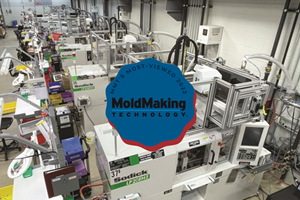- Early planning. Streamline the upfront process of preparing a quote and getting the job rolling in the shop with a fast response system and good estimating software. This is a sales management issue. Days lost getting the customer committed cannot be recovered.
- Project management. Implement job tracking and product lifecycle management (PLM). Schedule the equipment through the departments so that the mold build flows throughout the production phase with a minimum of glitches. Knowing the big picture, project management and task software are major players.
- Communication. It is imperative that constant communication between project management and the customer is maintained so that any questions or part changes can be addressed immediately and then communicated to engineering and production. Get all the information you need the day the bid is accepted because this—more than anything else—is what affects getting the job done, by getting it started on time.
- Ensure compatibility. Make the engineering and production software as compatible as possible so there is no chance of entities of the 3-D files being lost in translation.
- Realistic goals. Designers and engineers must understand what can be done in the real world, not on some computer monitor. Stop changing the design half way into the job. Try to see things from a toolmaker’s perspective. Understand there are only seven days in a week. Prompt feedback from the customer allows you to move forward building the mold. The customer or OEM must supply good data and information, even during the bidding process.
- Technology investment. Invest in accurate, powerful high-speed machining technology (eliminating the need to use multiple machines for roughing and finishing); accurate, easy-to-use and setup EDM with new technology for burning ribs and other details faster and deeper, and the ability to deliver fine surface finishes; workpiece and electrode pallet systems; robots for auto-loading/unloading technology; a good CAD system that enables short mold design cycles and automates the extraction of electrodes; and, a good CAM system(s) that uses templates that can be recycled job-after-job, with fast code generation time, and generates efficient G code.
- Team building. Implement periodic reviews of the process with the entire team. Accept all suggestions and discuss how to improve the process as a team. Invest in team building and education, because without them, none of this will work.
- Automate. Automate the mold build; automate so that your design software will create the machine programs to do the 2-D plate work; automate designs with components that are in libraries that can be added without creating newly designed features; automate the mold build plan so that every operation is being tracked on software, moved from department-to-department with schedules that give a variety of choices dependent on the machine work loads and efficiency is maintained through the shop; and, automate equipment with work cells and robots which run unattended.
- Build relationships. Have strong relationships with outside service providers so that when your production is backed up you can have work performed by the outside service companies, avoiding delays in the schedule. Build relationships with vendors of cutters, components and services that support quick-turn.
- Standardize. Standardize in any and all ways possible. Standardize the approach to manufacturing as much as is possible: from design to programming to standardized mold components. This industry has been built by craftsmen and women that find unique ways to turn steel blocks into extensions of themselves and the machines used to produce plastic parts/products. Unfortunately, we have also taken too much time re-inventing the wheel in many instances. Our designers are creative people that like to put their mark on the product as do the programmers. If we insist on standardized approaches in these areas we can then focus on the real business—cutting cavity and core.
This list is compiled from the most popular answers to a reader poll.
Related Content
OEE Monitoring System Addresses Root Cause of Machine Downtime
Unique sensor and patent-pending algorithm of the Amper machine analytics system measures current draw to quickly and inexpensively inform manufacturers which machines are down and why.
Read MoreMMT Chats: Solving Schedule and Capacity Challenges With ERP
For this MMT Chat, my guests hail from Omega Tool of Menomonee Falls, Wisconsin, who share their journey with using enterprise resource planning (ERP)—and their people—to solve their schedule and capacity load monitoring challenges.
Read MoreMold Builder Uses Counter-Intuitive Approach for Mold Challenges
Matrix Tool Inc. answers customers’ hard questions with creative solutions for cavity spacing, tool sizing, runner layout and melt delivery that reveal the benefits of running in a smaller press size at lower cavitation but higher yield.
Read MoreHow to Improve Your Current Efficiency Rate
An alternative approach to taking on more EDM-intensive work when technology and personnel investment is not an option.
Read MoreRead Next
Reasons to Use Fiber Lasers for Mold Cleaning
Fiber lasers offer a simplicity, speed, control and portability, minimizing mold cleaning risks.
Read MoreHow to Use Strategic Planning Tools, Data to Manage the Human Side of Business
Q&A with Marion Wells, MMT EAB member and founder of Human Asset Management.
Read More















